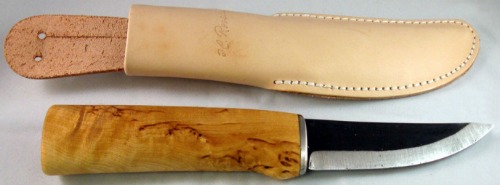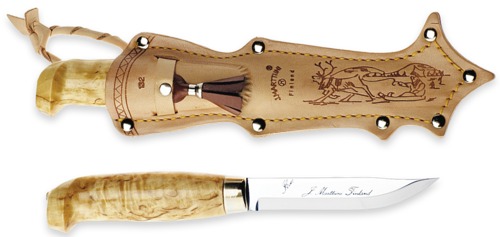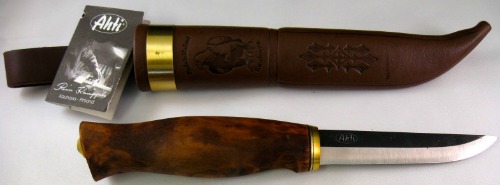|
Scandinavian Knives, Part 1 - Finland By Gary Zinn  I grew up thinking of knives as tools, because that is just what they were on the small West Virginia farm where I was born and raised. At the time, all men and most boys in the community (and not a few women and girls) routinely carried pocket knives and used them frequently for many tasks. In addition, there were kitchen knives, butcher knives, hunting knives and even machetes, which we called corn knives, for we used them to cut off corn stalks at harvest time. Perhaps this background explains why I have long been intrigued by the type of knives that are made in the Scandinavian countries. Their design is obviously straightforward and functional, made by and for people who use them as essential tools of their way of life. The prototypical Scandinavian knife is a fixed blade knife with a simple yet functional blade profile, featuring a straight spine, or a slightly dropped or upswept point. The distinctive, wide beveled "scandi grind" is used to form the sharpened edge. The blades of truly traditional knives would be individually forged from carbon steel and would be left "in the black" (unpolished). Contemporary production methods typically start with blade blanks stamped from sheets of either carbon or stainless steel and then use some variation of the stock removal method (cutting, grinding, filing) to do final shaping and finishing of the blades. The handle usually is northern birch wood fitted to the rattail tang of the blade. Handles made of antler, bone, leather, or some combination of these, usually along with wood, are not uncommon. The length, girth and shape of the handle is designed to give a secure and comfortable grip when the knife is being used. Typically, the only hardware on the handle is a simple bolster or ferrule at the front, plus a brass nut clamped or peened onto the end of the tang, where it protrudes slightly out of the butt of the handle. Metal finger guards, butt caps, or pommels are the exception, rather than the rule. Those who know and appreciate traditional Scandinavian knives often call them puukkos, a Finnish word used to denote the type of knife that I just described. Thus a knife of that style is commonly called a puukko, no matter where in Scandinavia it was made. Sensible blade lengths of three to five inches are most common. There are, though, enough shorter and longer blades for one to have a reasonable choice. Larger knives are often of the Saami (or Lapland) style, which is slightly different from the puukko style. I will discuss Saami style knives further in Part 2 of this article. The Roselli knife (see above) is a modern example of the Scandinavian knife style. This is a no frills design, with a die forged blade and solid wood handle, with a thin bolster to protect the front end. The typical Scandinavian pouch type leather sheath is often very plain, but sometimes artistic frills are added. Dress knives may have embellished sheaths, as the example below shows.  I started this project intending to do a general survey of significant Scandinavian commercial knife makers, thinking it would make an article of moderate length. I was aware of the Swedish firms Morakniv and Fallkniven and of Helle (Norway) and I though I might be able to identify three to five additional manufacturers that would be worth noting. What I did not realize is that Finland is the epicenter of the Scandinavian knife making industry, with nearly as many notable knife making enterprises as Norway and Sweden combined. (How many of you also missed that one?) I rethought my writing plan and decided to do two articles, this one (Part 1) featuring Finnish knife makers and the other (Part 2) those in Norway and Sweden. Perhaps it is appropriate that Finland gets separate recognition, because the Finns gave us the generic name puukko to denote the prototypical Scandinavian knife style. What about Denmark, which is also an important Scandinavian country? I could not identify any notable Danish makers of commercial outdoor knives. There are, though, some Danish custom knife makers who make elegant examples of traditional Scandinavian knives. (Iceland and Greenland are also Scandinavian countries, but not hot beds of cutlery manufacture.) FINNISH KNIFE MANUFACTURERS Ahti Finnish Puukko knives are made by the firm R. Kamppila & Son in Kauhava, Finland. I did not find a company website, so the following information was gleaned from the marketing websites of Brisa of Finland, Puukko Cutlery and Ragweed Forge. Among the vendors just mentioned, Brisa catalogs nine Ahti knives (plus three fish fillet models), Puukko Cutlery shows six and Ragweed Forge has fourteen. The knives have carbon or stainless steel blades (depending on specific model), curly birch handles and a minimum of brass furniture. Leather pouch type belt sheaths come with all models. (Except the fillet knives have thermoplastic handles and molded plastic sheaths.) The Ahti No. 9608 Vaara modelis a representative specimen of these knives. It has a 3.75 inch carbon steel blade, 0.75 inches wide at the base and 0.125 inches thick at the spine. The curly birch handle is stained dark brown and sealed with linseed oil. A brass disk bolster is mounted at the front of the handle and a brass nut secures the end of the rattail tang at the butt of the handle. The handmade, deep pouch belt sheath is dyed dark brown to match the handle. A brass band around the sheath below its mouth and a plastic protective liner inside the sheath are nice additional touches. The Vaara is 8.3 inches long overall and its weight is listed as three ounces, sheath included. This seems light, but this is a relatively slender utility knife, so it does not have as bulky a blade as many puukko knives. Puukko Cutlery sells the knife for $95. Here is an image of the complete package.  EnZo Knives EnZo is a newcomer on the Finnish cutlery scene. The company, named Brisa of Finland, was established only two decades ago (1996). EnZo is the brand name given to the featured line of knives they produce. Being a modern company, it is not surprising that they use modern materials and methods to produce knives with modern styles and features. The EnZo brand lineup includes four each of fixed blade and folding models. The blade steels used include O1, O-1C, D2, Sandvik 12C27, N690Co and ELMAX. Handle materials include Micarta, curly birch and G10. The sheaths are mostly leather. Most models sport scandi blade grinds, but a few are flat ground. The flagship model of the EnZo brand is a fixed blade knife called the Trapper, with 19 specific variations cataloged on the company website. The Trapper is 8-1/4 inches long overall, with a 3-7/8 inch blade and weighs about five ounces (eight ounces in the sheath). 2017 USA retail prices generally range between $110 and $150 from reputable Internet vendors, with the price variation representing different blade steels and handle materials. Although the Trapper has the typical appearance of a Scandinavian fixed blade knife, it cannot be called a puukko. I say this, because it is a full tang knife, rather than having the rattail tang that is normally used on traditional puukkos. Brisa also markets Ahti, Polar, Lappi, Kauhava, and Erapuu brand knives. These are traditional puukko and Saami style knives, made by independent producers. Except for the Ahti brand, I could not find enough other information to include these knives in this article. Iisakki Jarvenpaa Iisakki appears to be the patriarch of Finnish knife businesses, with a history that traces back to 1904 under its present name. Iisakki knives are divided into five groups on their website, which they call traditional models, special models, fish and fillet knives, hunting and scout knives and Lapland models. The Lapland model is a representative Finnish working knife. Ragweed Forge shows three sizes of this knife, with 3-3/8, 3-7/8 and 5.0 inch blades of carbon steel. Each has a curly birch handle about as long as the blade, dressed with unobtrusive front bolsters and flat pommels (in the Saami knife style). Leather pouch sheaths are included. The three sizes are priced at $47, $59 and $79 in the Ragweed Forge online catalog. However, two of the three sizes were out of stock at the time I visited the site, as were the majority of over a dozen other Iisakki models shown. This illustrates the problem with the Iisakki brand. Ragweed Forge was the only U.S. vendor I found that carries them and even there availability was sparse. Evidently the company is not putting any emphasis on serving the U.S. market, or production cannot meet the demand. Kellam Knives Worldwide Kellam offers an impressive fourteen lines of fixed blade knives, plus two models of folding knives. Blades may be carbon or stainless steel, depending on the particular line or model. Curly birch handles, stained or unstained, are the norm on the fixed blade knives. A good example of the Kellam fixed blade knives is the Wolverine model in the Wild Finn line. The Wolverine knife has a 3.7 inch carbon steel blade and is 8.25 inches long overall, with an ergonomically shaped handle of stained curly birch. The knife weighs 3.2 ounces, while the leather pouch sheath adds another ounce to the carry weight. 2017 U.S. Internet vendor price for this knife is about $105. Marttiini Marttiini, which started business in 1928, is now a member of Rapala VMC, the Finnish fishing and outdoor gear conglomerate. In addition to knives produced under its own brand name, the company makes Rapala brand fillet and other fishing and outdoor knives (see below). Marttiini knives are divided into seven categories, six with fixed blades and one group of folders. In the fixed blade categories, those labeled Outdoor and Traditional are mostly puukko style knives, plus a few with Saami (Lapp) style handles. The Hunting knife category features more contemporary designs. Steels used in the fixed blade knives may be either carbon or stainless, depending on the model, plus a few select knives feature Carbinox T508 or Damascus steel and some blades get what is called a Martef coating. Handle materials are primarily curly birch, with pakkawood or rubber (thermoplastic) used here and there. Sheaths are leather, ranging from plain to fancy.  I used an image of the Lynx Knife 132 to show a fancy sheath. The Lynx Knife 131 is the same knife with a less elaborate sheath. The Lynx Knife design has been a mainstay in the Marttiini lineup since the early 1930s, so I will use the 131 model as an illustration of the typical Marttiini puukko type knife. The knife has a 4.33 inch stainless steel blade with a handle of equal length. The handle is varnished curly birch and the leather sheath is plainer than that of the 132 model, but still quite nice. The knife weighs 2-3/4 ounces and the sheath is 1-1/4 ounces. The 2017 U.S. retail price for this knife is about $50. Rapala Rapala is a brand name that needs no introduction. I remember when the Rapala Original Floating Minnow took the fishing lure world by storm and the rest is history. The Rapala name has considerable marketing power beyond lures and fish filleting knives is one of the areas in which it is manifested. The 22 models of fillet knives listed on the Rapala website are all variations or derivatives of the original Fish 'n Fillet model. That knife comes in three blade lengths, 4, 6 and 7-1/2 inches. The blades are thin, flexible stainless steel, mounted to varnished birch handles. The knife comes with a leather pouch sheath and a small sharpening tool is thrown into the bargain. 2017 U.S. prices are about $20 to $27, depending on blade length. The Rapala website lists additional knives in the utility, hunting knife and kitchen knife categories, but their fillet knives are doubtless the best selling of their cutlery products. All Rapala brand knives are made in the Marttiini factory, as far as I know; the Rapala brand name is really a powerful marketing vehicle for Marttiini products. Roselli Knife Roselli, like Ahti, uses knife designs and materials that faithfully reflect the character of the puukko type knife. Their flagship pattern, called simply the Hunting Knife, exemplifies this.  The blade is die forged Krupp W75 carbon steel, left in the black on the finished knife. The handle is curly birch treated with linseed oil and the only additional hardware is a narrow bolster at the front of the handle. The deep pouch sheath is unembellished. To me, the whole package has a "less is more" elegance. The Hunting Knife blade is four inches long and the overall length of the knife is nine inches. It weighs about 4-1/4 ounces. The 2017 U.S. market price is about $115. Other models in the Roselli regular production lineup include the Carpenter, Grandfather, Grandmother, Little Carpenter, Big Leuku, and Little Leuku. Differences in blade length and/or handle profile distinguish between the different models. Roselli does not make any folding knives. Also, there is a four model set of high end knives made with a proprietary steel called Roselli Wootz UHC (ultra high carbon) and two collector knives with the same steel. These are, I believe, special order items. WHERE TO BUY FINNISH KNIVES Availability of the Finnish knife brands I have featured range from ubiquitous (Rapala fillet knives) to very limited availability (Iisakki brand knives). Most reputable Internet knife marketers carry one or more Scandinavian knife brands. See Where to Buy Knives (Part 1) for a list of some leading Internet knife vendors. In research for this article, I found two U.S. businesses that specialize in marketing Scandinavian knives. These are Puukko Cutlery and Ragweed Forge. Finnish knives carried by Puukko Cutlery include the Ahti, KPP and Roselli brands. Ragweed Forge catalogs Ahti, Iisakki, Marttiini, Roselli and Wood Jewel knives. Optics Planet is a sleeper website for knife shoppers. Among the brands covered in this article, Optics Planet catalogs a good selection of EnZo, Kellam, Martini and Rapala brand knives. I did not feature the KPP and Wood Jewel brands in this article, because I could not find company websites or other resources that I could use to study their products. Anyone who is interested in one of these brands will have to do their own research. Finally, some of the knife makers have online catalogs, which I take to indicate that one could order directly from the factory. I have no idea how easy or hard that might be, given potential complications involving currency exchange and international shipping. SHARPENING SCANDI GROUND KNIVES Scandi ground blades are very easy to sharpen. The Ragweed Forge website has a page on the subject, which begins as follows: "These knives are exceptionally easy to sharpen freehand. The wide bevel is simply laid flat to the stone when sharpening. You want to remove metal from the entire width of the bevel to preserve the correct angle." The tools and techniques for sharpening Scandi blades are summarized on the page and links are provided to a couple of recommended YouTube show-and-tell videos on the subject. CONCLUSION The manufacture of commercial outdoor knives is alive and well in Finland. The Finnish production knife makers surveyed range from those who make products faithful to the traditional puukko design (e.g., Ahti, Roselli) to others that lean toward more contemporary styles and features (e.g., EnZo). It is clear that Finnish cutlers are primarily oriented to fixed blade knives, with EnZo being the only firm putting much emphasis on folding knives. Forward to Scandinavian Knives, Part 2 - Norway and Sweden. |